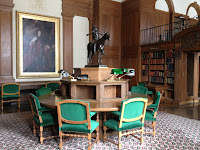 Dirk was off at 10am today to give a talk on Libya at Harvard, but before he left he made arrangements for Peter and I to spend the morning meeting some of the staff on campus. Peter sat in on a first year International Relations class and I had a tour of the e-learning environment. Dartmouth has an extensive media program and provides significant IT and electronic media resources and support for all of its other academic programs and disciplines.
Dirk was off at 10am today to give a talk on Libya at Harvard, but before he left he made arrangements for Peter and I to spend the morning meeting some of the staff on campus. Peter sat in on a first year International Relations class and I had a tour of the e-learning environment. Dartmouth has an extensive media program and provides significant IT and electronic media resources and support for all of its other academic programs and disciplines.  The teaching and learning environment regularly utilises mobile technology (the town is nearly all wifi) and the Tuck School of Business at Dartmouth (founded in 1900 as the first graduate school of management in the USA) has long been recognized as among the leading business schools in the world. It has recently opened a multiscreen tele-conferencing centre that allows experts from a variety of locations to interact with the students in real time and face to (electronic) face.
The teaching and learning environment regularly utilises mobile technology (the town is nearly all wifi) and the Tuck School of Business at Dartmouth (founded in 1900 as the first graduate school of management in the USA) has long been recognized as among the leading business schools in the world. It has recently opened a multiscreen tele-conferencing centre that allows experts from a variety of locations to interact with the students in real time and face to (electronic) face. 
We also toured their new theatre and movie studio and met up with students involved their Tiltfactor program which specialises in researching and designing ‘games for social change’. The gamer we spoke to showed us their latest award winning game ‘Zombie Pox’ which addresses an alarming world-wide trend indicating a shift away from vaccinations by ‘enhancing the perceived value of vaccination for curbing disease spread’ and once mastered this concept can be extended so that the players ‘appreciate the interrelationships of other open-ended public health problems’.
Tiltfactor’s strategies have been researched and tested in New York, Beijing, Shanghai, Rwanda and South Africa and they have won awards for their games that incorporate ‘in game learning’ on gender stereotypes and human values. It was great to hear see students using something they love to ‘to create a more just and equitable world’. The sign on their wall told me that they were ‘committed to investigating the power of story, systems thinking and empathy to craft powerful experiences that shape people’s lives by reducing biases and stereotypes, promoting wellness and increasing global awareness’. This website is definitely worth a look:
http://www.tiltfactor.org 








.JPG)
.JPG)
.JPG)
.JPG)
.JPG)
.JPG)




.JPG)
.JPG)
.JPG)
.JPG)

.JPG)
.JPG)
.JPG)
.JPG)
.JPG)
.JPG)
.JPG)
.JPG)
.JPG)
.JPG)
.JPG)
.JPG)
.JPG)
.JPG)
.JPG)
.JPG)
.JPG)
.JPG)
.JPG)


.JPG)
.JPG)